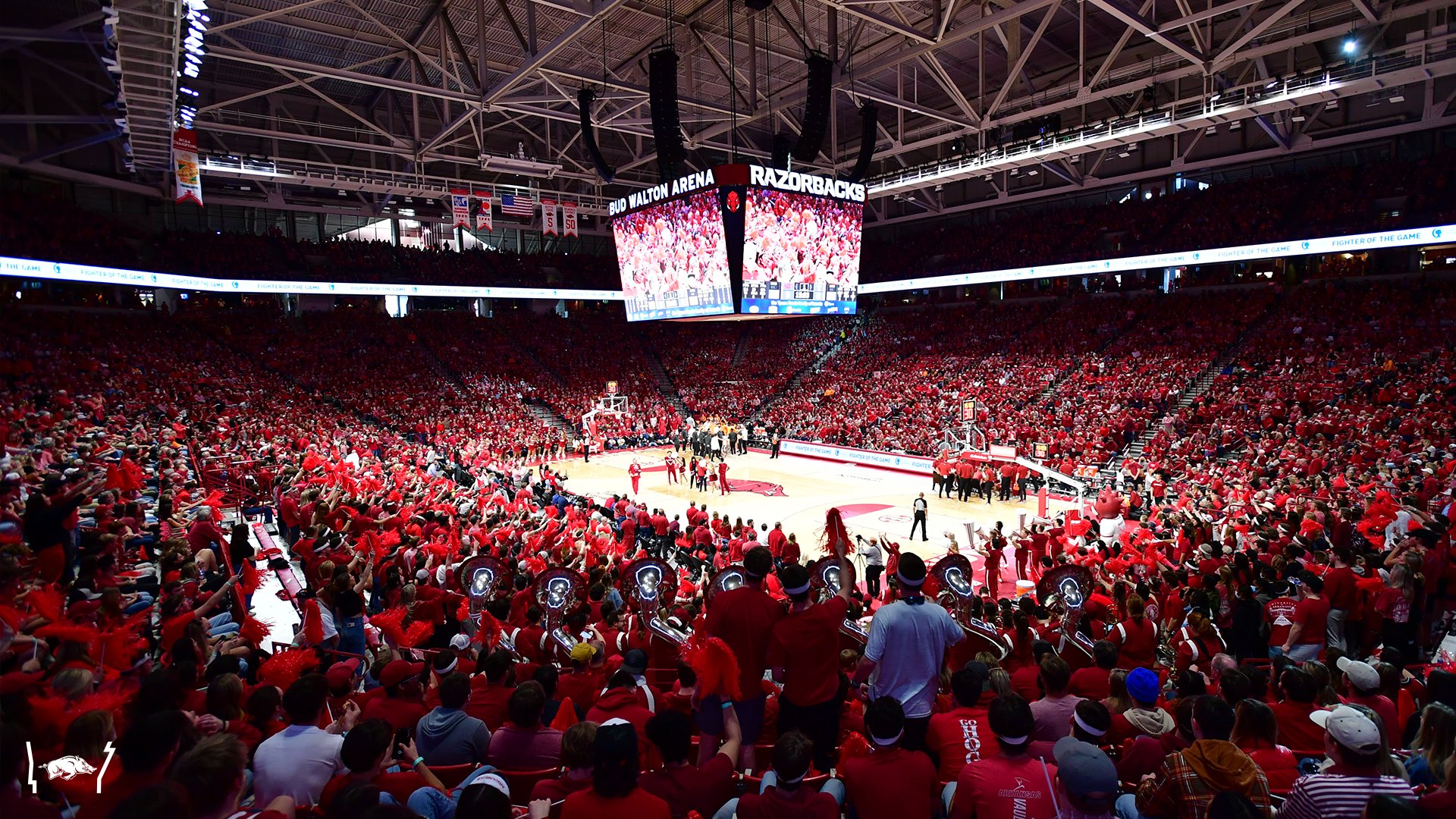Welcome to the SEC quarterfinals. Missouri barely made LSU break a sweat in the second round, so the Bayou Bengals face off with Arkansas for the third time this season. Arkansas beat LSU in Baton Rouge, 65-58, in a game that Xavier Pinson missed. Then Pinson returned and was terrible as Arkansas beat LSU 77-76 in Fayetteville just last week. Given that LSU is a bad matchup for the Hogs generally, beating the Tigers three times in one season would be a really impressive accomplishment.
This preview will have a closer look at Will Wade’s offense and how it gave Arkansas fits in last week’s game. If you want to learn more about LSU’s aggressive pack line defense, check out the preview of last week’s game.
Meet the Tigers
Confused? Check out the advanced stats glossary to learn more about the stats cited here.
As always, our two models make picks. The matchup model constructs a predicted box score based on team stats, while the traditional model uses each team’s adjusted efficiencies and adds a momentum factor.
- Matchup Model: LSU 72, Arkansas 70
- Traditional Model: LSU 71, Arkansas 68
In the last preview, we discussed why the models like LSU so much. It’s not just ours: Ken Pomeroy, the NET, and ESPN’s BPI all say LSU is better than Arkansas. That’s slightly misleading as a huge part of that is because LSU ran up some obscene scores against decent competition in the non-conference. During most of SEC play, Arkansas has been the better team, as evidenced by the Hogs’ two victories over the Tigers. But the Tigers have peaked late, nearly beating the Hogs in Fayetteville and then topping Alabama to end their regular season.
Team Profile

That win in Fayetteville actually knocked LSU out of the title of #1 adjusted defense, but LSU still ranks 15th in Adjusted Scoring Margin. As you can see, Arkansas has been the better team in each squad’s last 10 games and last 4 games.
Personnel Profile

We’ve already made the case for Tari Eason as the SEC’s best player: he leads the conference in BPM, and has the best RPM of all non-Kentucky players in the conference. Recall that BPM, or Box Plus-Minus, is a qualitative measure of that player’s contributions to the team, adjusted for the quality of the team he plays for and the opponents he faces. Real Plus-Minus, or RPM, tells us the net scoring margin per 100 possessions while that player is on the floor. So Eason directly contributes +13.8 adjusted net points per 100 possessions to his team, and LSU outscores its opponents by 21 points per 100 possessions while he’s on the floor.
The positions listed here are calculated by the BPM algorithm. It iterates over each player’s stats and assigns a position that is a continuous variable between 1 and 5: if the value is between 1 and 2, the player is a point guard; 2-3, a shooting guard; 3-4, a small forward (or combo guard); 4-5, a power forward; and exactly 5, a center. So these aren’t listed positions, they are actual positions.
Arkansas has struggled against players listed as power forwards this season, which is why this is such a tough matchup. The Hog defense ranks a dismal 338th in the country in game score allowed to opposing power forwards. Now we’ll check out how LSU used its power forwards — Eason and Darius Days — to tear up the Hogs defense.
When LSU has the rock

This looks like it should be advantage Arkansas, but that’s why the Hogs’ defensive game score of 30 in last week’s game is so surprising. That was the Hogs’ worst defensive performance since the 0-3 start to SEC play ended.
In theory, LSU should struggle to make both 2- and 3-pointers and should turn it over a ton, while largely being neutralized in offensive rebounding and free throw attempts. The shooting part did happen last week: LSU shot poorly from both 2 and 3. But the Tigers had just 10 turnovers — the numbers here suggest they should have had between 15 and 18 — and LSU was not “neutralized” on the offense glass: they snagged 22 offensive rebounds against a top-30 defensive rebounding team.
The Hogs are honestly lucky that these two key stats fell apart on them and they won anyway. This time, Arkansas might force a lot of turnovers and clean up on the boards and win easily. But it’s going to be tough.
LSU’s attacking offense
Will Wade’s offensive scheme has always been his signature: LSU’s suddenly-good defense arrived after the Tigers switched to an aggressive pack line scheme last year. Wade’s continuity ball screen offense is very similar to Eric Musselman’s offense at Arkansas: it uses lots of screens and movement to attack the rim and take high-percentage shots.
I initially planned to diagram LSU’s base scheme, but when I rewatched last week’s game, I realized there was no point. LSU largely abandoned it in the second half in favor of simple 5-out looks designed to let Eason and Days get downhill off the dribble. It actually looked a lot like what Baylor did to Arkansas in last year’s Elite Eight. Remember this?
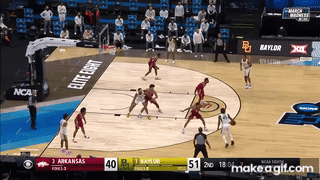
Sorry for that memory.
LSU actually opened the last game with Pinson running their base offense. However, with about 10 minutes left, a strategy switch happened. LSU decided to move the focus from Pinson and onto Eason. Specifically, they wanted to test Williams’ defensive ability. What follows is a sequence of plays covering about five minutes that ends with Williams fouling out. These aren’t Jaylin’s finest moments, although they were mostly just great plays by LSU.
Here’s how it starts: LSU has no true big on the floor, so Williams is assigned to guard Eason. Arkansas doesn’t like Williams coming out the perimeter (we discussed drop coverage in the Tennessee preview), so Eason is able to get an open 3 when Williams doesn’t come out to cover him:
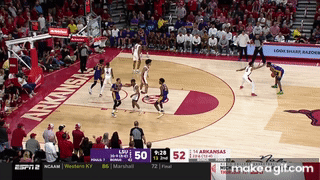
On the very next trip down the floor, LSU has subbed “traditional” big man Efton Reid back into the game, so Williams guards him. Reid draws Williams out, while Eason draws Umude to the top of the key for a two-man game:
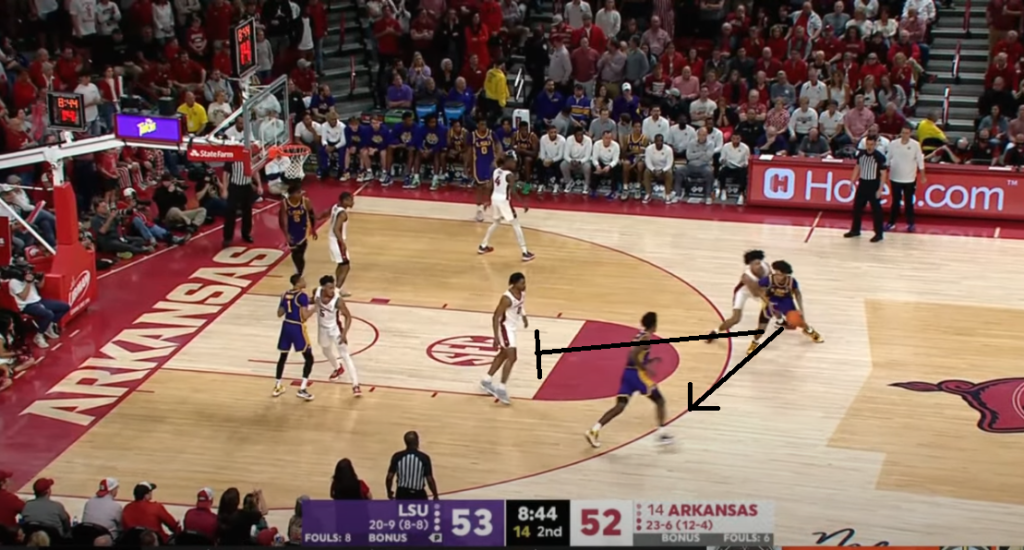
LSU’s goal here is to have Reid pass to Eason and then screen Umude, thus creating an Eason-on-Williams game at the top of the key. That’s not what Williams wants. But Umude actually fights through the screen, so Eason takes Umude to the hole instead:
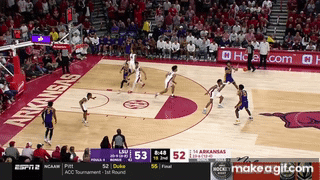
This is mostly a good play by Eason, but it sure looks like Williams, in his anxiousness to take a charge (watch him pull up), gives up a chance to help Umude on the defense, letting Eason sink the difficult shot.
Flash forward: a couple plays later: Reid is back out, so Williams is matched on Eason. LSU simply clears everyone out and lets Eason iso Williams, drawing a blocking foul (Williams’ third):
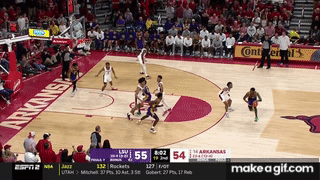
At this point, Williams’ lunch is being eaten, so the Hogs have to make a change. Muss decides to switch Au’Diese Toney on Eason: good call, put your best defender on their best offensive player. But there’s a problem: Williams still has to cover somebody. That somebody is Mwani Wilkinson.
LSU goes with a 5-out look, sneaks Wilkinson into the corner, and waits for Williams to come help in the lane after Umude and Notae appear to mess up a switch:
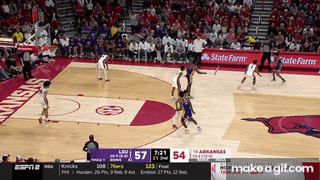
Next trip down the floor: same alignment for both teams. Now LSU decides to see what Eason can do against Toney. Eason isos Toney on the drive, but Notae helps. Eason makes a spin and throws up a wild shot, which is no good. However, the play isn’t over:
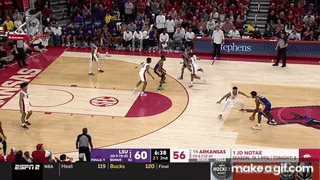
That and-one putback was Williams’ fourth foul. Williams has four inches on Eason and was in rebounding position. He really can’t let that happen.
Just a couple trips later, Days ends Williams’ night by catching him in the no-charge circle:

In a stretch of exactly five minutes, LSU scored 17 points and drew three fouls on Williams. It probably could have gotten worse after Kamani Johnson came in, but Will Wade took Eason out at this point. I’m not kidding. Eason had 21 points and was single-handedly dominating, and Wade took him out right at the moment the Tigers needed him to finish the game.
I’m guessing that Wade’s theory was that Eason had four fouls, so he didn’t want him to foul out and he could just use a timeout to get him back in the game on offense (which he did with 2 minutes left). But an Umude 3-pointer had cut the lead to 71-70 when Eason made his final bucket:
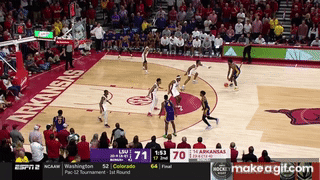
As I said above, shades of Baylor in the Elite Eight. The Hogs were just getting iso’d to death by really good players.
On Arkansas’ next offensive possession, Eason grabbed Toney’s arm on a rebound, picking up his fifth foul and ending his night. Arkansas was able to escape after that.
How does Arkansas defend this?
If that sequence makes you a little bit nervous, you are certainly not alone. What if LSU comes out of the gate with that strategy, instead of deploying it with 10 minutes left? Yes, Eason fouled out in just 18 minutes on the floor, but what if the officials in Tampa let ’em play and Arkansas can’t get fouls on him?
It’s important to note that Williams was providing a ton of value as a screener and passer on offense during this time. He helped draw a few of Eason’s fouls. So taking him out obviously isn’t the answer. And when LSU went to the 5-out looks to take advantage of mismatches on offense, they were ceding mismatches on defense: their lack of height allowed Arkansas to get to the rim more easily and draw fouls.
If Toney is out or limited, then I think the pressure ramps up on Trey Wade. Wade was the worst player on the floor in the last LSU game, going minus-6 in nine minutes. He had zero rebounds and Arkansas was out-rebounded 9-1 while he was on the floor with LSU snagging four offensive rebounds. Wade has proved his value as a rebounder many times, including the Tennessee game, but he’s got to make an impact against an opponent with athletic forwards. Even if he’s not athletic enough to help defensively, he can punish LSU on the offensive boards if they choose to stick with the smaller lineup.
When Arkansas has the rock

The Hog offense did fine in the last game. LSU largely took Notae away, but the Razorbacks shot well on 2-pointers (58%), got to the free throw line (as expected), and avoided turnovers. Umude had 23 and Toney had 18. LSU’s defense is strong against point guards but ranks 333rd in the country against combo guards and small forwards, especially on catch-and-shoot 3-pointers, putbacks, and baseline drives.
You can read the in-depth look at the Tigers’ pack line defense here, but the basics are that the Tigers limit easy dribble drives and paint entry passes, at the expense of giving up open 3-pointers and offensive rebounds. Hero ball won’t work against LSU but punishing their aggression with good spacing works just fine.
Keys to the Game
- Score with Umude. Stanley Umude had 23 points in the last matchup, and he’ll need another big game for the Hogs to survive. He needs to be especially sharp on the wing and corner 3’s that LSU’s defense allows.
- Punish LSU’s smaller lineups. LSU’s 5-out looks gave Arkansas all kinds of problems in Fayetteville, but they create bad matchups for the Tiger defense. Arkansas has to dominate the offensive glass if LSU insists on using a smaller lineup. That will draw fouls and create easy shots. This is a big opportunity for Trey Wade.
- Force more turnovers. LSU’s offense is very turnover-prone, but the Hogs only forced 10 turnovers in Fayetteville. Of course, the Tigers don’t turn it over much when they are just running isos against Hog defenders who can’t stay in front of them. When they do make an overly-aggressive pass, the defense has to punish them.
The latest from Fayette Villains, straight to your inbox
Enter your email to subscribe and receive new post alerts and other updates. You can unsubscribe at any time.
